
|
|
3 December, 1998
Thursday, December 3rd, 1998
Hi! Just when I think there can't be another thing on this trip to top what
I've already done…along comes a day (night) like today! The Dry Valleys of
Antarctica…probably one of THE most fabulous places I've ever visited on
Earth. Actually, it didn't look much like Earth at times…I felt like I was on
the moon or Mars. Amid all of the snow and ice in Antarctica, it seems
strange to find a desert landscape. The never-ending winds of this region are
about the only thing that has changed the look of this landscape for millions
of years.
The Trans Antarctic Mountain range stretches for more than 1,370 miles and is
one of the world's great mountain chains. Many of its peaks are higher than
13,000 feet above sea level, although they are all but buried in ice. This
mountain range acts as a barrier for the world's largest body of fresh water-
the east Antarctic ice sheet. Glaciers, great rivers of ice, have carved deep
valleys through this area, as they force their way to the Ross Sea. Since the
mountains have been uplifted in the past 30 million years, some of the
mountains are now high enough to keep the ice sheet from flowing through all
of the former outlets.
Robert Scott discovered the Dry Valley region by accident, on his Antarctic
expedition in 1901-1904. He descended into one of the valleys while sledging
(hauling his supplies) down a glacier toward McMurdo Sound. He couldn't
really explore this area, since his equipment was made for sledging over ice.
Scott and his men had to re-trace their steps and climb up the glacier again.
In 1909, Shackelton sent two men to explore the eastern end of what is now
called Taylor Valley. In 1911, Robert Scott sent Griffith Taylor, his
geomorphologist from the Terra Nova expedition, to sledge up one glacier and
down another, and then hike through the valleys. Taylor Valley was named
after Griffith Taylor, and I was surprised to learn that Lake Bonney was named
after one of Robert Scott's dogs.
I was anticipating this field trip ALL day. It had been postponed for the
past two nights, due to poor visibility in the mountains and high winds.
Today was blue sky, sunny, and BEAUTIFUL! I worked all day on little odds and
ends. I cleaned out the drill shack, which was covered in mud. I had a
meeting for the CRP open house coming up this Sunday. I worked on answering
e-mail and writing. I was really happy when I could catch an early dinner and
head to my dorm room to change into that darn ECW gear. It's not the most
comfortable stuff, and certainly not flattering, but it sure keeps me warm!
And, as I've mentioned before, it's required if we fly on a HELO or leave
McMurdo on a field trip.
I reported in at the helicopter hangar at 6:00 PM, along with Gary Wilson, Tom
Janecek, Rosie Askin, Jaap Van Der Meer, Mike Tabecki, Reed Scherer and Graeme
Wilson. The eight of us were sandwiched into the back of the HELO, cameras
ready, helmets on and plugged in for communication between pilot and
eachother, and seat belts fastened. We were off the ground by 6:40 PM.
Tonight we flew out of McMurdo through the gap (pass) between McMurdo and
Scott Base. After circling around Scott Base, we were pointed in the
direction of the Trans Antarctic Mountains and the Dry Valleys.
Since it was such a clear evening, I got a tremendous view out my side of the
copter. I was facing McMurdo and Mt. Erebus (yes, more Mt. Erebus photos!).
The best part for me was thinking about all I've done since arriving in
Antarctica. On many of my field trips I've traveled the same path out of
McMurdo…and I could re-trace my various trips from the air. I saw Big
Razorback, Tent and Inaccessible Islands (all from my day with the scientists
studying seals), the Erebus Glacier tongue (where the ice caves are located),
Cape Evans (Robert Scott's hut), the Barnes Glacier, and Cape Royds
(Shackelton's hut and the PENGUINS!). It was nice to reminisce and have one
more look at this incredible landscape from the air!
I could see beyond Cape Royds, out to the open water. I would love to be in
McMurdo when the ice breaker arrives later in the summer season. Now THAT
would be something to see from the air. Off in the distance there was the far
coast of Ross Island, and another smaller island, Beaufort Island, was also
visible. I love the views you can get from the air…shows you just how vast
this Antarctic landscape really is. There seems to be no end to it…quite
unbelievable!
By 7:20 PM we were landing in the first of several locations in the Dry
Valleys. We had already flown into the mountains and over glaciers and valleys
below. This was a special moment, because it was the first time I was going
to set foot on the main part of the continent of Antarctica. I've been on
Ross Island (Antarctica) for the whole time I've been in and around McMurdo.
This was going to be different. The pilot, John, landed the HELO on Nussbaum
Riegel-a ridge above Taylor Valley, the Taylor Glacier, Lake Bonney (at the
end of the Taylor Glacier) and the Suess Glacier off on a side mountain.
Gary Wilson, who served as our tour guide for the night, immediately started
giving us facts about this region. I had to pay attention carefully, because
I don't have the geology background that the rest of my group does! Still, I
learned a lot tonight about the geologic history of the Dry Valleys. At this
first stop, we found many ventifacts. Ventifacts are rocks that are shaped
and polished by windlbown sand and snow. These rocks are smooth on some
surfaces and have been "chiseled" by the wind into sharper corners on others.
The ventifacts are carved into unusual and sometimes complicated shapes. We
also saw examples of dykes-strips of intrusive igneous rock that has been
injected into earlier intrusive igneous rock and sediment. Intrusive rocks
are those that cool under the Earth's surface. Pumice is an example of an
igneous rock that cools above the Earth's surface (extrusive), while granite
is a good example of a rock that cools below the Earth's surface. Lots of
granite could be found on Nussbaum Riegel. The way that some of the dykes
stood up out of the other rock, reminded me of a "comb" on a rooster or a
little ridge of rock jutting out of the ground. These rocks were also darker
in color, making them easy to spot.
We probably spent about an hour at this stop, although it was hard to tell,
since the time went by so fast. Before we knew it we were strapping in for
our next short HELO ride… toward Finger Mountain, over Pandora's Spire and
Taylor Glacier, toward Aztec Mountain. We landed on the shoulder of Aztec
Mountain, which is about 6,500 feet above sea level. Our group climbed UP
Aztec Mountain to about 7,000 feet above sea level, to a sandstone level of
the mountain. Gary wanted to look at the coal measures (made of sandstone and
siltstone) to try to find fossilized leaves of an ancient deciduous conifer
called Glossopteris. He used a geology hammer to chip away and separate the
layers of rock, then pried the layers apart with his hands or the hammer. I
used the time to do the same with my hands, and also took quite a few
photographs of the area and the people in my group.
We weren't at the top of Aztec Mountain, but still had incredible views of
Beacon Valley, hanging glaciers, and other valleys and mountains surrounding
us. The hike up and down Aztec was strenuous, if only because of the change
in altitude. Back in the HELO in 1 hour and 45 minutes….and off to the next
destination. We crossed over a formation below called the Labrinth…carved
channels. Scientists don't know how they got there, but Gary did tell us that
the channels are much larger than we think they are from the air. You can fly
helicopters in them, and I can see where they got the name Labrinth…it's like
a maze down there!
John took us over the Asgard Range and to the Airdevronsix Icefalls (named
after the Navy division that used to provide the plane and helicopter
support). The Icefalls spill over the edge of the Wright Upper Glacier and
are absolutely incredible!!!!! I've been walking by a painting of this area
for weeks now (it's in Crary Lab) and suddenly the painting takes on a whole
new meaning. John flew us close to the Icefalls, heading in both directions
so that each side of the HELO could get a good look. WOW! I don't think the
digital photo taken from a distance will do it justice, but I want you to get
a look at this scene!!!
Within minutes John was looking for a place to land on the Dais. This reminds
me of a plateau, but wasn't as flat as it looked from the air. It was kind of
tilted, but level enough to land the helicopter. Part of our group walked to
one edge of the plateau and took a look at a small lake below that never
freezes (even in the cold Antarctic winter) because it has such a high salt
content. We walked to the opposite edge of the Dais and gazed down at Lake
Vanda in the Wright Valley below. On the steep sides of the valley there are
hanging glaciers…meaning, they hang down the side of the main valley. I know
they have to be HUGE and I wonder why they don't break off and tumble down
into the valley. The glaciers we could see include: Bartley, Meserve, Hart,
Goodspeed, and the Denton Glacier.
When John took off from the Dais, he flew directly INTO the Wright Valley and
he followed the frozen, winding Onyx River. This small stream was showing
signs of melting for the season, but wasn't yet flowing freely. Off to the
left…one of the remote field camps. Our landing in Wright Valley was another
perfect one….smooth as can be. Gary had John put the copter down near two
small "mesas" on the valley floor. Prospect Mesa, the larger of the two, has
been a topic of study for many years. Some of its sediments were deposited
from ancient fjords in Antarctica. The top sediments were a glacial deposit,
then the fjord deposit, and the bottom sediments were a glacial deposit laid
down in water. On Prospect Mesa Gary showed us shells-called pectens-which is
the name of a mollusk. These shells are a few million years old.
The remainder of John's route toward McMurdo Sound followed the Wright
Valley…to the Wright Lower Glacier and eventually the Wilson Piedmont Glacier.
We headed to Marble Point to refuel, which only took about 10-15 minutes. We
were able to get out of the HELO and stretch our legs…eight people scrunched
inside the HELO…tight quarters. Plus, by this time of the night, after the
on/off business with the helmet for hours, my hair was sticking out and
blowing all over the place in the wind. No one in our group even had the same
helmet we started with because we had been rotating around in the HELO to give
everyone a chance at being by the window. By this time it was around 1:00 in
the morning, and people were beginning to fade!
I enjoyed the 40 minute ride back across McMurdo Sound. John took us directly
over the ice edge and open water and we THINK we saw Emperor penguins. They
certainly looked a lot larger than Adelies, and the flight assistant made the
comment that they looked like bowling pins down on the ice. I'm counting it
as Emperors anyway. Why not! I liked seeing the open water up close. For
weeks now, I haven't seen much variety in landscape…other than some mountains
looking higher than others and a few islands, huge glaciers, and icebergs.
Not that it's been bad at all. But…the blue water stretched out for
miles…everywhere to the left of the helicopter. I am starting to imagine what
it will be like to get back to New Zealand and see lots of color again.
The Kiwi passengers were dropped off at Scott Base first…five minutes later we
were landing in McMurdo. It was 2:00 AM…what a long night. Thanks to Gary
for being a GREAT tour guide and to John for flying us safely around the Dry
Valleys tonight. At last, all of us trudged up the hill from the HELO pad to
our dorms…I was exhausted! What a FABULOUS night! I hope you enjoy the
photographs of one of the most unique places on Earth…the Dry Valleys of
Antarctica. Talk to you tomorrow!
Betty :)
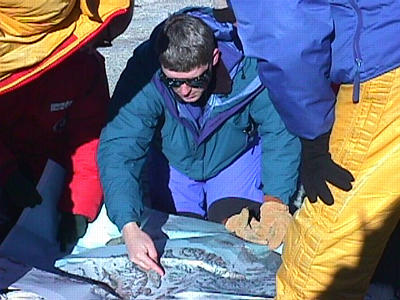
After landing on Nussbaum Riegel, Gary got out a map and oriented us to our surroundings. He pointed out the various features of the landscape, including Lake Bon ney, Taylor Glacier, and Suess Glacier.
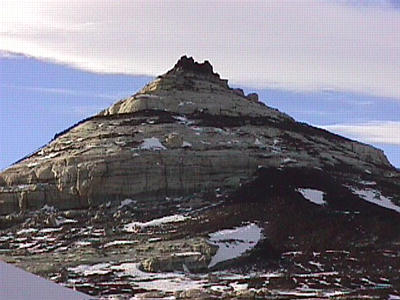
Aztec Mountain...we climbed up to one of the higher bands of sandstone.

We did a lot of hiking around tonight. At each stop we spent at least an hour walking around, checking out the landscape.
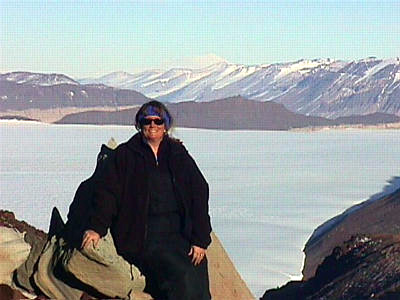
This was the view from where we stood on Aztec Mountain. We could see glaciers everywhere, valleys below and peaks around us! Incredible!!!
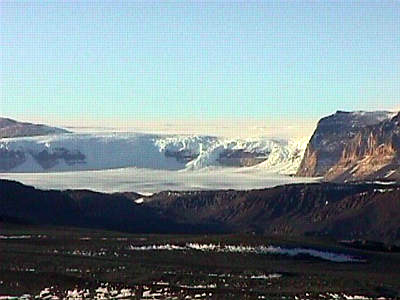
I don't know if you can even tell how beautiful the Airdevronsix Icefalls are from this photo, taken on the Dais.
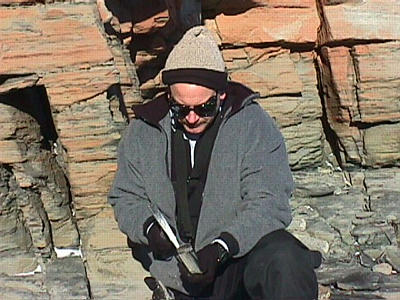
Tom Janecek was hammering apart pieces of rock, looking for fossilized leaves.
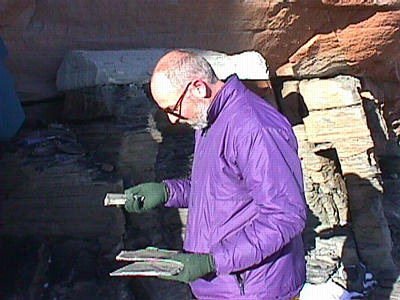
Mike Tabecki was looking for Glossopteris as well. We didn't find any tonight.
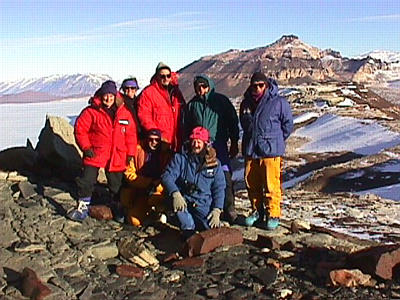
Here's a group shot, minus Reed, who was nice enough to take the photo! This was on the side of Aztec Mountain.
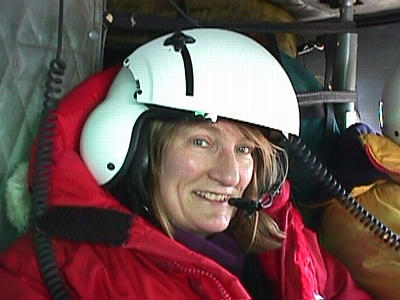
I know Rosie Askin enjoyed the trip as much as I did. This photo was taken at the beginning of our field trip....before we were all exhausted! Rosie wants to send a special hello to her daughter, Ruth!

Everyone wanted their photo taken with this gorgeous view in the background. This is Jaap Van Der Meer, from the University of Amsterdam, Holland.
Contact the TEA in the field at
.
If you cannot connect through your browser, copy the
TEA's e-mail address in the "To:" line of
your favorite e-mail package.
|
